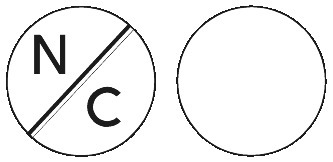SUMMARY CMI
NORGESIC®
Consumer Medicine Information (CMI) summary
The full CMI on the next page has more details. If you are worried about using this medicine, speak to your doctor or pharmacist.
1. Why am I using NORGESIC?
NORGESIC contains the active ingredients orphenadrine citrate and paracetamol. NORGESIC is used to treat tension headache and headaches caused by muscle spasms in the back of your head and neck. It also helps relax certain muscles in your body and to relieve the pain and discomfort caused by sprains, strains or other injury to your muscles.
For more information, see Section 1. Why am I using NORGESIC? in the full CMI.
2. What should I know before I use NORGESIC?
Do not use if you have ever had an allergic reaction to NORGESIC or any of the ingredients listed at the end of the CMI.
Talk to your doctor if you have any other medical conditions, take any other medicines, or are pregnant or plan to become pregnant or are breastfeeding.
For more information, see Section 2. What should I know before I use NORGESIC? in the full CMI.
3. What if I am taking other medicines?
Some medicines may interfere with NORGESIC and affect how it works.
A list of these medicines is in Section 3. What if I am taking other medicines? in the full CMI.
4. How do I use NORGESIC?
The usual dose of NORGESIC in adults is two tablets three times a day. Your doctor will prescribe the correct dose for you. Follow instructions provided on the pack.
More instructions can be found in Section 4. How do I use NORGESIC? in the full CMI.
5. What should I know while using NORGESIC?
| Things you should do |
|
| Things you should not do |
|
| Driving or using machines |
|
| Drinking alcohol | Avoid drinking alcohol while using NORGESIC.
|
| Looking after your medicine |
|
For more information, see Section 5. What should I know while using NORGESIC? in the full CMI.
6. Are there any side effects?
Side effects include nausea, dry mouth, blurred vision, drowsiness, rash, trouble urinating, fainting, fast or pounding heartbeat, hallucinations, trouble breathing, unusual bruising or bleeding, confusion and constipation.
For more information, including what to do if you have any side effects, see Section 6. Are there any side effects? in the full CMI.
FULL CMI
NORGESIC®
Active ingredients: orphenadrine citrate and paracetamol
Consumer Medicine Information (CMI)
This leaflet provides important information about using NORGESIC. You should also speak to your doctor or pharmacist if you would like further information or if you have any concerns or questions about using NORGESIC.
Where to find information in this leaflet:
1. Why am I using NORGESIC?
2. What should I know before I use NORGESIC?
3. What if I am taking other medicines?
4. How do I use NORGESIC?
5. What should I know while using NORGESIC?
6. Are there any side effects?
7. Product details
1. Why am I using NORGESIC?
NORGESIC contains the active ingredients orphenadrine citrate and paracetamol. Orphenadrine citrate is a skeletal muscle relaxant. It acts in the central nervous system to produce muscle relaxant effects. Paracetamol is used to treat or prevent pain and reduce fever.
NORGESIC is used to treat tension headache and headaches caused by spasm of the muscles in the back of your head and neck.
It is also used to help relax certain muscles in your body and to relieve the pain and discomfort caused by sprains, strains or other injury to your muscles.
2. What should I know before I use NORGESIC?
Warnings
Do not use NORGESIC if:
- You are allergic to orphenadrine citrate, paracetamol or any of the ingredients listed at the end of this leaflet. Always check the ingredients to make sure you can use this medicine.
- You have any of the following conditions:
- Glaucoma
- Intestinal blockage or oesophageal disease
- An enlarged prostate or bladder obstruction
- Myasthenia gravis (muscle weakness) - The packaging shows signs of tampering or is after the expiry date.
Check with your doctor if you:
- have any heart, liver, or kidney problems
- have Gilbert's syndrome
- have Glucose–6–phosphate–dehydrogenase deficiency
- have any alcohol abuse problems
- are sensitive to aspirin or other anti-inflammatory medicines or intolerant to pain relievers
- are malnourished
- have asthma
- have any other medical conditions
- are taking other medicines containing paracetamol
- take any medicines for any other condition.
During treatment, you may be at risk of developing certain side effects. It is important you understand these risks and how to monitor for them. See additional information under Section 6. Are there any side effects?
Pregnancy and breastfeeding
Check with your doctor if you are pregnant or intend to become pregnant.
Talk to your doctor if you are breastfeeding or intend to breastfeed.
Children under 12 years old
- Do not give NORGESIC to children under the age of 12 years.
3. What if I am taking other medicines?
Tell your doctor or pharmacist if you are taking any other medicines, including any medicines, vitamins or supplements that you buy without a prescription from your pharmacy, supermarket or health food shop.
Some medicines may interfere with NORGESIC and affect how it works including:
Phenothiazine medicines used to treat serious emotional and mental disorders
Medicines used to relieve stomach cramps or spasms
- Medicines which have a sedating effect
- Alcohol
- Medicines to prevent blood clots
- Medicines that affect how quickly food leaves the stomach, such as metoclopramide, domperidone, propantheline, some antidepressants and narcotic painkillers
- Antibiotics such as chloramphenicol, rifampicin or flucloxacillin
- Probenecid used for gout
- Zidovudine used for HIV/AIDS
- Cholestyramine
- Anti-epileptic medicines.
Check with your doctor or pharmacist if you are not sure about what medicines, vitamins or supplements you are taking and if these affect NORGESIC.
4. How do I use NORGESIC?
How much to take
- The usual dose is two tablets three times a day.
- Do not take more than the recommended dose unless your doctor tells you to.
- Follow the instructions provided and use NORGESIC until your doctor tells you to stop.
When to take NORGESIC
- NORGESIC should be used as directed by your doctor or pharmacist.
- Do not change the dose unless your doctor tells you to do so.
If you forget to take NORGESIC
NORGESIC should be used regularly at the same time each day. If you miss your dose at the usual time and remember within an hour or so of the missed dose, take it straight away.
If it is almost time for your next dose, skip the dose you missed and take your next dose when you are meant to.
Do not take a double dose to make up for the dose you missed.
If you use too much NORGESIC
If you think that you have used too much NORGESIC, you may need urgent medical attention. Overdose with paracetamol-containing medicines can lead to liver damage.
You should immediately:
- phone the Poisons Information Centre
(by calling 13 11 26), or - contact your doctor, or
- go to the Emergency Department at your nearest hospital.
Do this even if there are no signs of discomfort or poisoning.
5. What should I know while using NORGESIC?
Things you should do
Call your doctor straight away if you:
- become pregnant
Remind any doctor, dentist or pharmacist you visit that you are using NORGESIC.
NORGESIC may cause dryness of the mouth. For temporary relief use sugarless gum or sweets, melt some ice in your mouth or use a saliva substitute. If dry mouth persists, talk to your dentist.
Things you should not do
- Do not give NORGESIC to anyone else even if they have the same condition as you.
- Do not take NORGESIC to treat any other complaints unless your doctor tells you to.
Driving or using machines
Be careful before you drive or use any machines or tools until you know how NORGESIC affects you.
NORGESIC may cause blurred vision or drowsiness in some people.
Drinking alcohol
Tell your doctor if you drink alcohol.
Drinking alcohol whilst using NORGESIC may increase the occurrence or severity of side effects such as drowsiness.
Looking after your medicine
Follow the instructions on the carton on how to take care of your medicine properly.
Store NORGESIC below 30°C in a cool dry place away from moisture, heat or sunlight; for example, do not store it:
- in the bathroom or near a sink, or
- in the car or on windowsills.
Keep it where young children cannot reach it.
Getting rid of any unwanted medicine
If you no longer need to use this medicine or it is out of date, take it to any pharmacy for safe disposal.
Do not use this medicine after the expiry date.
6. Are there any side effects?
All medicines can have side effects. If you do experience any side effects, most of them are minor and temporary. However, some side effects may need medical attention.
See the information below and, if you need to, ask your doctor or pharmacist if you have any further questions about side effects.
Less serious side effects
| Less serious side effects | What to do |
| Speak to your doctor if you have any of these less serious side effects and they worry you. |
Serious side effects
| Serious side effects | What to do |
| Call your doctor straight away, or go straight to the Emergency Department at your nearest hospital if you notice any of these serious side effects. |
Tell your doctor or pharmacist if you notice anything else that may be making you feel unwell.
Other side effects not listed here may occur in some people.
Reporting side effects
After you have received medical advice for any side effects you experience, you can report side effects to the Therapeutic Goods Administration online at www.tga.gov.au/reporting-problems. By reporting side effects, you can help provide more information on the safety of this medicine.
Always make sure you speak to your doctor or pharmacist before you decide to stop taking any of your medicines.
7. Product details
This medicine is only available with a doctor's prescription.
What NORGESIC contains
| Active ingredients (main ingredients) | Orphenadrine citrate Paracetamol |
| Other ingredients (inactive ingredients) | Magnesium stearate Colloidal anhydrous silica Microcrystalline cellulose Pregelatinised maize starch Gelatin |
Do not take this medicine if you are allergic to any of these ingredients.
What NORGESIC looks like
NORGESIC is a white tablet with N/C marked on one side and no marking on the other. It is packaged in blister packs containing 8, 24 or 100 tablets.
Registration number: AUST R 156623.
Who distributes NORGESIC
iNova Pharmaceuticals (Australia) Pty Limited
Level 10, 12 Help Street
Chatswood NSW 2067
Tel: 1800 630 056
This leaflet was prepared June 2025
Published by MIMS August 2025


 C18H23NO.C6H8O7. M.W. 461.51.
C18H23NO.C6H8O7. M.W. 461.51.
